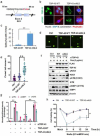This is a preprint.
Endogenous TDP-43 mislocalization in a novel knock-in mouse model reveals DNA repair impairment, inflammation, and neuronal senescence
- PMID: 38343852
- PMCID: PMC10854316
- DOI: 10.21203/rs.3.rs-3879966/v2
Endogenous TDP-43 mislocalization in a novel knock-in mouse model reveals DNA repair impairment, inflammation, and neuronal senescence
Update in
-
Endogenous TDP-43 mislocalization in a novel knock-in mouse model reveals DNA repair impairment, inflammation, and neuronal senescence.Acta Neuropathol Commun. 2025 Mar 8;13(1):54. doi: 10.1186/s40478-025-01962-9. Acta Neuropathol Commun. 2025. PMID: 40057796 Free PMC article.
Abstract
TDP-43 mislocalization and aggregation are key pathological features of motor neuron diseases (MND) including amyotrophic lateral sclerosis (ALS) and frontotemporal dementia (FTD). However, transgenic hTDP-43 WT or ΔNLS-overexpression animal models mainly capture late-stages TDP-43 proteinopathy, and do not provide a complete understanding of early motor neuron-specific pathology during pre-symptomatic phases. We have now addressed this shortcoming by generating a new endogenous knock-in (KI) mouse model using a combination of CRISPR/Cas9 and FLEX Cre-switch strategy for the conditional expression of a mislocalized Tdp-43ΔNLS variant of mouse Tdp-43. This variant is either expressed conditionally in whole mice or specifically in the motor neurons. The mice exhibit loss of nuclear Tdp-43 concomitant with its cytosolic accumulation and aggregation in targeted cells, leading to increased DNA double-strand breaks (DSBs), signs of inflammation and DNA damage-associated cellular senescence. Notably, unlike WT Tdp43 which functionally interacts with Xrcc4 and DNA Ligase 4, the key DSB repair proteins in the non-homologous end-joining (NHEJ) pathway, the Tdp-43ΔNLS mutant sequesters them into cytosolic aggregates, exacerbating neuronal damage in mice brain. The mutant mice also exhibit myogenic degeneration in limb muscles and distinct motor deficits, consistent with the characteristics of MND. Our findings reveal progressive degenerative mechanisms in motor neurons expressing endogenous Tdp-43ΔNLS mutant, independent of TDP-43 overexpression or other confounding etiological factors. Thus, this unique Tdp-43 KI mouse model, which displays key molecular and phenotypic features of Tdp-43 proteinopathy, offers a significant opportunity to further characterize the early-stage progression of MND and also opens avenues for developing DNA repair-targeted approaches for treating TDP-43 pathology-linked neurodegenerative diseases.
Keywords: DNA double-strand break; TDP-43; amyotrophic lateral sclerosis; inflammation; motor deficits; motor neuron; muscle atrophy; neurodegeneration; senescence.
Conflict of interest statement
Conflict of interest The authors declare no conflicts of interest.
Figures









Similar articles
-
Endogenous TDP-43 mislocalization in a novel knock-in mouse model reveals DNA repair impairment, inflammation, and neuronal senescence.Acta Neuropathol Commun. 2025 Mar 8;13(1):54. doi: 10.1186/s40478-025-01962-9. Acta Neuropathol Commun. 2025. PMID: 40057796 Free PMC article.
-
Motor neuron disease-associated loss of nuclear TDP-43 is linked to DNA double-strand break repair defects.Proc Natl Acad Sci U S A. 2019 Mar 5;116(10):4696-4705. doi: 10.1073/pnas.1818415116. Epub 2019 Feb 15. Proc Natl Acad Sci U S A. 2019. PMID: 30770445 Free PMC article.
-
A Commentary on TDP-43 and DNA Damage Response in Amyotrophic Lateral Sclerosis.J Exp Neurosci. 2019 Oct 10;13:1179069519880166. doi: 10.1177/1179069519880166. eCollection 2019. J Exp Neurosci. 2019. PMID: 31656396 Free PMC article.
-
Slow motor neurons resist pathological TDP-43 and mediate motor recovery in the rNLS8 model of amyotrophic lateral sclerosis.Acta Neuropathol Commun. 2022 May 14;10(1):75. doi: 10.1186/s40478-022-01373-0. Acta Neuropathol Commun. 2022. PMID: 35568882 Free PMC article.
-
Expanding the TDP-43 Proteinopathy Pathway From Neurons to Muscle: Physiological and Pathophysiological Functions.Front Neurosci. 2022 Feb 3;16:815765. doi: 10.3389/fnins.2022.815765. eCollection 2022. Front Neurosci. 2022. PMID: 35185458 Free PMC article. Review.
References
Publication types
Grants and funding
LinkOut - more resources
Full Text Sources
Research Materials
Miscellaneous

